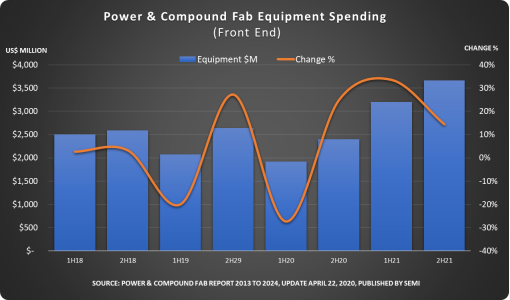As the spread of the coronavirus eases, companies around the world are looking for ways to resume business operations in a safe and secure manner. Adhering to the minimum physical distance guidelines between employees plays a key role.
Global Semiconductor Sales Decrease 3.6 Percent in First Quarter of 2020
First-quarter sales decreased 3.6 percent compared to the previous quarter, which is in line with typical seasonal trends, and increased 6.9 percent compared to the first quarter of 2019.
Semiconductor Downturn to Continue Into 2020 Due to COVID-19 Impact
Ahead of the COVID-19 virus, worldwide semiconductor revenue declined 12.2% in 2019 to $418 billion, according to the latest update to the Semiconductor Applications Forecaster (SAF) from International Data Corporation (IDC).
Keysight Unveils Advanced Analytics Software to Speed Semiconductor Design Validation without Sacrificing Reliability
Keysight Technologies, Inc. (NYSE: KEYS), a leading technology company that helps enterprises, service providers and governments accelerate innovation to connect and secure the world, today announced PathWave Waveform Analytics, an edge-to-cloud computing application that improves anomaly detection and reduces data storage costs in pre-silicon validation using machine learning algorithms.
Connected Devices Have a Key Role to Play in an Era of Pandemics
Technology has a history of helping to track and treat viruses. And, with the World Health Organization (WHO) declaring COVID-19 a global pandemic, people are rightly asking themselves how new technologies such as the Internet of Things (IoT), AI, and Big Data can be employed to slow down the proliferation of pandemics and avoid a future global health crisis.
STMicroelectronics Helps Meet Functional-Safety Norms with Certified Software for STM32 and STM8 Families
STMicroelectronics has released three functional-safety packages that simplify development of safety-critical industrial, medical, consumer and automotive products based on STM32 and STM8 microcontrollers and microprocessors.
Power and Compound Fab Spending to Rebound in Second Half of 2020, Set New Record in 2021
The 2020 rally will help blunt a drop in annual spending, now projected at 8 percent, as fabs ride the COVID-19 recovery wave.
Vacuum Systems for the Treatment of COVID-19 Patients in Brazil
Brazil currently has the most confirmed COVID-19 cases in South America. Already in March, hospital capacities for intensive medical care of corona patients were expanded, and several field hospitals were established.
Aldec’s New HES FPGA Accelerator Board Targets HPC, HFT and Prototyping Applications plus Hits the ‘Price/Performance’ Sweet Spot
Aldec, Inc., a pioneer in mixed HDL language simulation and hardware-assisted verification for FPGA and ASIC designs, has launched a new FPGA accelerator board for high performance computing (HPC), high frequency trading (HFT) applications and high speed FPGA prototyping.
STMicroelectronics Simplifies Design and Boosts Safety with Highly Integrated Universal Car-Lock Controller
The STMicroelectronics L99UDL01 automotive universal door-lock IC integrates six MOSFET half-bridge outputs and two half-bridge gate drivers with protection and diagnostic functions that enhance safety, simplify design, and save space.

